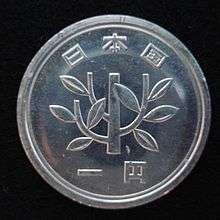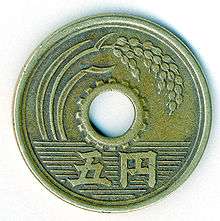1 yen coin
| Japan | |
| Value | 1 Japanese yen |
|---|---|
| Mass | 1 g |
| Diameter | 20 mm |
| Thickness | 1.5 mm |
| Edge | Smooth |
| Composition | 100% Al |
| Years of minting | 1955–present |
| Obverse | |
 | |
| Design | Young tree with the words "State of Japan" above, and "1 Yen" below. |
| Design date | 1955 |
| Reverse | |
 | |
| Design | "1" in a circle with year of issue in kanji- (Showa Period year 64- 1989) |
| Design date | 1955 |
The 1 yen coin (一円硬貨 Ichi-en kōka) is the smallest denomination of the Japanese yen currency. The first Japanese one yen coin was minted in 1871, and was made out of silver. Eventually gold coins were also produced causing co-circulation among the two. Silver one yen coins ceased production in 1914. Brass one yen coins were made in the late 1940s, but the current design was first minted in 1955. The current design is made up of an aluminium alloy which has remained unchanged since the coin was first minted. In the early 2010s increasing usage of electronic money led to a lack of demand, and production of the coin was confined to mint sets until 2014. Like the U.S. penny, the Japanese mint has suffered losses due to a rising cost of the base metal it takes to produce the coins.
Current design
The one yen coin is the oldest modern denomination coin, the design has remained the same since its introduction in 1955.[1] The obverse of the coin has a figure "1" in a circle that represents one yen, below the digit is the year of issue which is written in kanji. The reverse side has a young tree, intended to symbolize the healthy growth of Japan.[2]
History

The first Japanese one yen coin was minted in 1871, at first these coins were primarily minted in silver. The obverse of these coins featured a dragon with a circular inscription around it. The reverse had a radiant sun surrounded by a wreath, with the chrysanthemum emblem (a symbol of the Japanese Imperial Family) flanked by floral patterns above. The following year though Japan switched to the Gold standard in order to keep up with countries in North America, and Europe.[3] Production of silver one yen coins was halted, and new small gold coins took their place. Through 1874-1875, one-yen silver coins were again minted with a new design only to be halted again sometime in 1875 in favor of "Trade Dollars". Both silver and gold coins co-circulated after 1878 when Japan went with a bimetallic standard, and production again resumed of silver one yen coins. Gold one yen coins were minted until 1880, while the silver ones lasted until 1914.[4][3]
Coinage was reformed in 1948 with the issue of a brass one yen coin, 451,170,000 coins were minted until production stopped in 1950.[5] The obverse features a numeral "1" with "State of Japan" above, and the date below, while the reverse reads "One Yen" with a floral pattern below it.[5] The current design was introduced in 1955, when the first aluminium one yen coin was minted, throughout its minting history the coin was fully halted (none released in mint sets) only once in 1968 due to excessive production.[6][2] In 1989 a national consumption tax was put into place that calculated prices down to single-yen units.[1]
In 2011 the increasing usage of electronic money led to a lack of demand for the coin; as a result one yen coins minted until 2013 were only released in mint sets. Production resumed in 2014 due to a consumption tax hike that went into effect. The cost of manufacturing 1 yen coins has become an issue in recent years. By the early 2000s the cost of manufacturing the one yen coin had risen, and by 2003 it cost 13 yen to mint a sheet of coins.[7] Measures were taken in 2009, including raising money from the private sector but that did not completely ease the cost of manufacture, which was 3 yen for each 1 yen coin in 2015.[8][9]
One-yen coins have also seen non monetary usage, since all 1 yen coins weigh just one gram, they are sometimes used as weights.[10] If placed carefully on the surface of still water, 1 yen coins will not break surface tension and thus can float.
Circulation figures
Showa
The following are circulation dates which cover Emperor Hirohito's reign. The dates below correspond with the 30th to the 64th year (last) of his reign. Coins for this period will all begin with the Japanese symbol 昭和 (Showa).
- Japanese coins are read with a left to right format:
- "Emperors name" -> "Number representing year of reign" -> "Year" (Ex: 昭和 -> 三十四 -> 年).
| Year of reign | Japanese date | Gregorian date | Mintage[6] |
|---|---|---|---|
| 30th | 三十 | 1955 | 381,700 |
| 31st | 三十一 | 1956 | 500,900 |
| 32nd | 三十二 | 1957 | 492,000 |
| 33rd | 三十三 | 1958 | 374,900 |
| 34th | 三十四 | 1959 | 208,600 |
| 35th | 三十五 | 1960 | 300,000 |
| 36th | 三十六 | 1961 | 432,400 |
| 37th | 三十七 | 1962 | 572,000 |
| 38th | 三十八 | 1963 | 788,700 |
| 39th | 三十九 | 1964 | 1,665,100 |
| 40th | 四十 | 1965 | 1,743,256 |
| 41st | 四十一 | 1966 | 807,344 |
| 42nd | 四十二 | 1967 | 220,600 |
| 43rd | 四十三 | 1968 | 0 |
| 44th | 四十四 | 1969 | 184,700 |
| 45th | 四十五 | 1970 | 556,400 |
| 46th | 四十六 | 1971 | 904,950 |
| 47th | 四十七 | 1972 | 1,274,950 |
| 48th | 四十八 | 1973 | 1,470,000 |
| 49th | 四十九 | 1974 | 1,750,000 |
| 50th | 五十 | 1975 | 1,656,150 |
| 51st | 五十一 | 1976 | 928,850 |
| 52nd | 五十二 | 1977 | 895,000 |
| 53rd | 五十三 | 1978 | 864,000 |
| 54th | 五十四 | 1979 | 1,015,000 |
| 55th | 五十五 | 1980 | 1,145,000 |
| 56th | 五十六 | 1981 | 1,206,000 |
| 57th | 五十七 | 1982 | 1,017,000 |
| 58th | 五十八 | 1983 | 1,086,000 |
| 59th | 五十九 | 1984 | 981,850 |
| 60th | 六十 | 1985 | 837,150 |
| 61st | 六十一 | 1986 | 417,960 |
| 62nd | 六十二 | 1987 | 955,775 |
| 63rd | 六十三 | 1988 | 1,269,042 |
| 64th | 六十四 | 1989 | 116,100 |
Heisei
The following are circulation dates in the reign of the current Emperor. Akihito was crowned in 1989, which is marked with a 元 symbol on the coin as a one year type. Coins for this period all begin with the Japanese symbol 平成 (Heisei). One yen coins dated between 2011 and 2013 were only released in mint sets; regular production resumed in 2014.
- Japanese coins are read with a left to right format:
- "Emperors name" -> "Number representing year of reign" -> "Year" (Ex: 平成 -> 三 -> 年).
| Year of reign | Japanese date | Gregorian date | Mintage[6] |
|---|---|---|---|
| 1st | 元 | 1989 | 2,366,970 |
| 2nd | 二 | 1990 | 2,768,953 |
| 3rd | 三 | 1991 | 2,301,120 |
| 4th | 四 | 1992 | 1,299,130 |
| 5th | 五 | 1993 | 1,261,240 |
| 6th | 六 | 1994 | 1,040,767 |
| 7th | 七 | 1995 | 1,041,874 |
| 8th | 八 | 1996 | 942,213 |
| 9th | 九 | 1997 | 783,086 |
| 10th | 十 | 1998 | 452,612 |
| 11th | 十一 | 1999 | 67,120 |
| 12th | 十二 | 2000 | 12,026 |
| 13th | 十三 | 2001 | 8,024 |
| 14th | 十四 | 2002 | 9,667 |
| 15th | 十五 | 2003 | 117,406 |
| 16th | 十六 | 2004 | 52,903 |
| 17th | 十七 | 2005 | 30,029 |
| 18th | 十八 | 2006 | 129,594 |
| 19th | 十九 | 2007 | 223,904 |
| 20th | 二十 | 2008 | 134,811 |
| 21st | 二十一 | 2009 | 48,003 |
| 22nd | 二十二 | 2010 | 7,905 |
| 23rd | 二十三 | 2011 | 456 |
| 24h | 二十四 | 2012 | 659 |
| 25th | 二十五 | 2013 | 554 |
| 26th | 二十六 | 2014 | 124,013 |
| 27th | 二十七 | 2015 | 82,004 |
| 28th | 二十八 | 2016 | - |
References
- 1 2 "Japanese Coins". www.nippon.com. December 6, 2015. Retrieved August 2, 2016.
- 1 2 "1 yen Aluminum Coin". Japan Mint. Retrieved August 5, 2016.
- 1 2 "Collecting Japanese Silver Yen: The Dragon Yen 1870-1914". Antique Marks. Retrieved August 5, 2016.
- ↑ "Japan Gold Complete Yen Set 1871-1880". Professional Coin Grading Service. Retrieved August 8, 2016.
- 1 2 Chester L. Krause & Clifford Mishler. Collecting World Coins 10th edition. Krause Publications. p. 432.
- 1 2 3 "Circulation figures". Japan Mint. Retrieved August 1, 2016.
- ↑ "景気対策を目的とした政府貨幣増発の帰結" (PDF) (in Japanese). www.murc.jp. Retrieved August 1, 2016.
- ↑ "1円玉原価割れも 金属値上がりでおカネづくり一苦労". www.nikkei.com. Retrieved August 1, 2016.
- ↑ Lester Somera (December 8, 2015). "Understanding the Yen: Bills and Coins". Matcha magazine. Retrieved August 5, 2016.
- ↑ "The Fate of the 1 Yen Coin – When will it lose its lustre in Japan?". www.stippy.com. June 24, 2012. Retrieved August 2, 2016.
